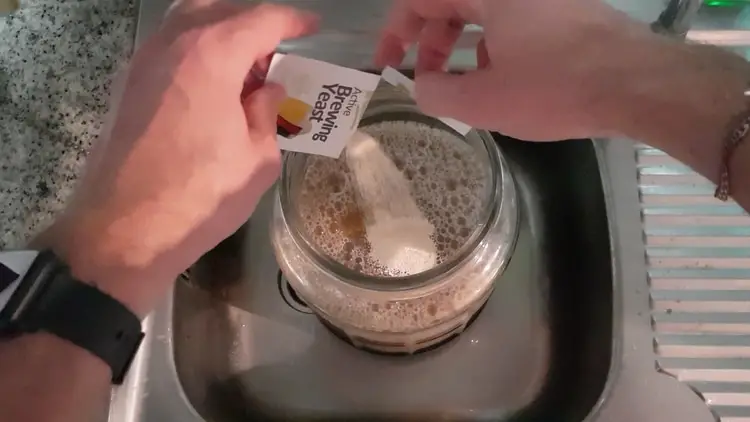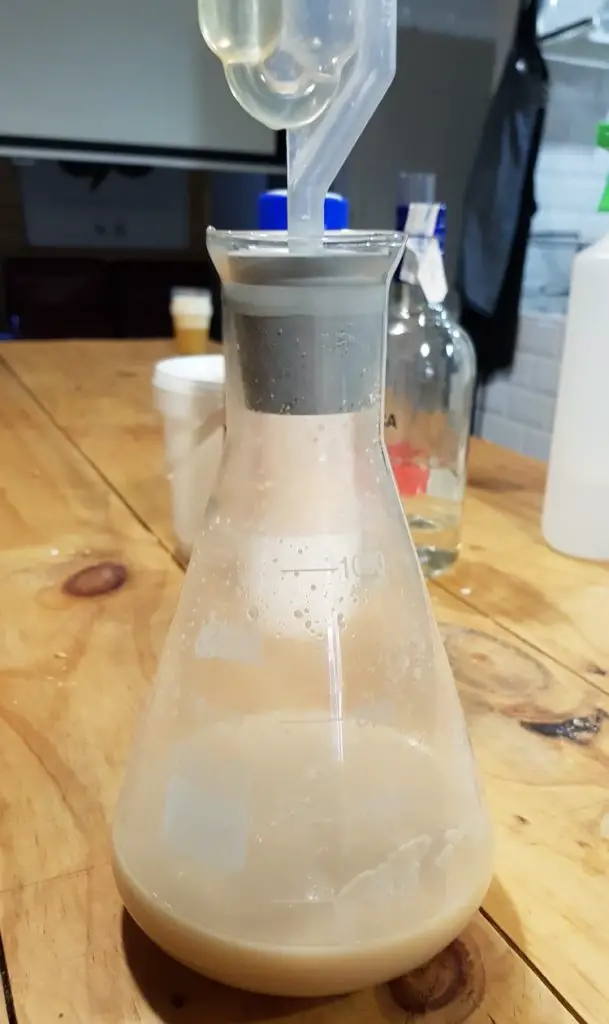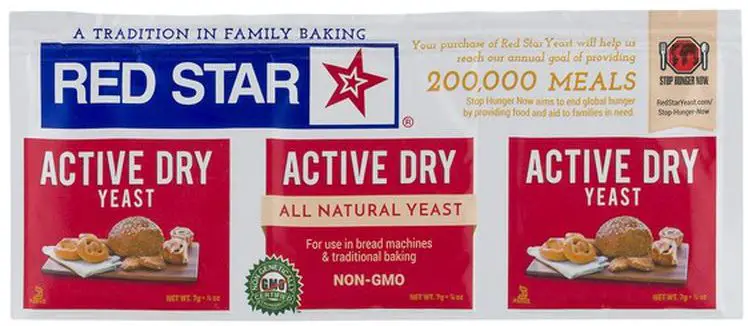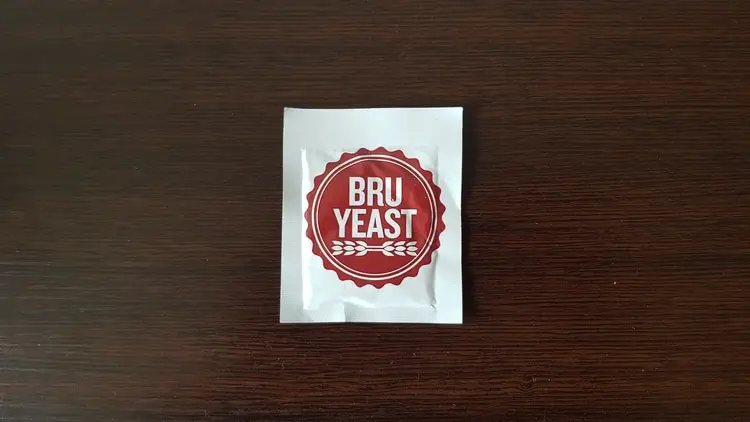Yeast is one of the most critical ingredients when brewing your own alcoholic beverages at home.
The use of different strains of yeast, even with all the other ingredients being the same, can impart different flavors in the finished brew.
No one yeast will work for all recipes. Always choose a good quality yeast that is developed for the recipe that you are using. Make sure that the yeast has been stored properly and is within it’s recommended use-by date.
We’ll explain what types of yeast should be used for homebrewing, depending on what recipe you’re making and some suggestions for popular styles of brew.
Choosing Between Different Types of Brewing Yeast
Brewing yeast is a particular type of yeast that has been formulated for brewing, and it can come in many different forms.
There are two main forms of brewing yeast, dry and liquid.
Dry brewing yeast looks very similar to the active dry yeast packets that you can find at the grocery store.
The yeast is sold in foil packets that protect the yeast from activation and is typically refrigerated before use. Each foil packet can usually ferment a five-gallon batch of brew.
Dry yeast must be activated before pitching. Pitching simply refers to the process of adding the yeast into the recipe.

Rehydrating Your Dry Yeast
Since dry pitching yeast can kill a large number of the yeast cells, ideally I recommend rehydrating the yeast before mixing it in.
It’s also a good idea to rehydrate yeast beforehand to make sure the yeast will activate.
To do so, follow this process:
- Allow dry yeast to come to room temperature
- Measure sterile water in a sanitized container to a weight ten times as much as the yeast. Heat it to 95-105°F (35-41°C).
- Dust dry yeast on to the water without letting it stick together. Leave it be for 15 minutes, then lightly stir.
- Once the yeast is reconstituted, stir again until creamy and let rest for five more minutes.
- Raise the yeast’s temperature slowly to within 15°F / 10°C of the wort temperature.
- Immediately put this cream into your fermentation vessel.
If you want, you can use a rehydration agent during this process, too.
Most recipes call for about 10 grams of brewer’s yeast for a five-gallon batch of beer.
You may need much more for some recipes, though, which may require you to make a starter for your yeast several days before you plan to brew.
Compared to liquid yeast, dry yeast is much more cost-effective.
The packets are much smaller and are more easily stored.
They also tend to last much longer than liquid yeasts.
Dry yeast packets also usually have many more yeast cell counts than liquid, which means after being rehydrated, they will start fermentation in your brew much more quickly.
What About Liquid Yeast?
Some brewers prefer to use liquid yeast for several reasons.
Liquid yeast can be pitched directly into the brew in many recipes.
It’s sold in sterile packets that are also refrigerated.
Most manufacturers recommend that you cut open the package with a pair of sterile scissors. The liquid yeast should be allowed to come up to room temperature before pitching as well, which usually takes about two hours.
Liquid yeast strains have much more variety than dried yeast strains.
For example, a quick search on MoreBeer.com, a leading homebrewing supply online store, carries about forty dry yeast options. In contrast, one manufacturer of liquid yeast alone has almost twice as many options.
Many styles of alcoholic beverages can’t be made without the specific strain of yeast for that style.
For example, a German Hefeweizen requires it’s specific yeast strain, while generic ales may be made with less specific yeast strains.
Liquid yeasts are generally fresher than the dry yeast counterparts.
While dry yeast might have a higher cell count than liquid yeast, the liquid yeast cells are more likely to survive due to being fresher.
Part of the reason why there are so many liquid yeast strains sold compared to dry is that they also produce better, more distinguishable flavors in the final product.
How to Create a Yeast Starter
Regardless of whether you use a dry or liquid brewing yeast, you may need to create a starter to increase your active yeast cell count before pitching into your brew.
If your yeast is old, or your starting specific gravity in your brew is too high, there is a chance that your yeast may die out before it can start multiplying enough to ferment your beer.
- First, boil about a pint of water in a saucepan on the stove to sanitize it.
- Add about half a cup of dry malt extract, which will provide nutrients for your yeast to eat.
- Boil this for ten minutes, then turn off the heat.
- Add about a quarter teaspoon of yeast nutrient.
- Cool this mixture down to about room temperature, or slightly above, then pour it into a sanitized glass jar.
- Then, add the yeast to this jar.
- If you have an airlock for the vessel you chose, pop that in, otherwise wrap the mouth of the jar loosely with plastic wrap and secure with a rubber band. The plastic wrap should be loose enough that as the yeast wakes up and starts producing carbon dioxide, the wrap can expand without bursting.
After a day or two, the yeast should be active, evident by white layers or foamy, creaminess in the mixture.
If there is no visible change in the mixture, your yeast may be dead.
Otherwise, the starter is ready to pitch into your wort.

How to Choose the Right Yeast Strain
When choosing a yeast strain for your recipe, you should consider five different variables.
These variables are:
- Brewing Temperature
- Attenuation
- Flocculation
- Alcohol Tolerance
- Flavor Profile
Brewing Temperature
In the same logic as alcohol tolerance, yeasts prefer certain temperature ranges to be awake and happy, making alcohol.
Take, for example, when making a starter for brewing, as outlined above, or when rehydrating dry yeast, the steps include mixing the yeast with warm water. The warmth of the water helps kick start the yeast from the dormant state.
BYO.com explains, to begin with, the fermentation process is exothermic, which means that the yeast will create heat as they consume sugar.
This will cause the temperature of the fermenter to increase. However, each yeast strain has its own temperature range where it’s happiest.
If you don’t have a way to control your brew’s fermentation temperature, the fermenter will likely be subjected to the ambient temperature of your space, either in your house or garage, or basement.
Some yeasts, like lager yeast, need a cooler temperature to ferment properly, between 40-54F / 4-12C.
Some ale yeasts are happier between 55-70F / 12-21C.
Even if the temperature doesn’t stop fermentation, stressed yeast can produce undesirable flavors in the final project.
If you anticipate that your fermenter might be exposed to temperatures much above 70F / 21C for long periods of time, especially temperatures above 75-80F / 24-26C, you should select a yeast strain that is developed for higher temperature fermentation.
Attenuation
Attenuation equates to the efficiency of the yeast.
The yeast will eat a certain percentage of all the available sugar in the unfermented recipe.
Low attenuation yeasts may consume 72% of the available sugar or less.
Medium attenuation ranges between 73-77%.
High attenuation is 78% or more.
When the yeast does not eat all the sugar, there will be some residual sugar in the final product that may leave it sweeter tasting.
For example, a high attenuation will result in lower residual sugar, producing what’s known as a “dry” mead, cider, or wine.
You can roughly measure the amount of attenuation when measuring the difference in the starting specific gravity and the final specific gravity.
This is called an apparent attenuation.
Sugar in the solution will make the specific gravity higher.
However, alcohol and water have different specific gravities, which makes the final specific gravity a little inaccurate.
Using yeasts with different attenuation will yield final products with different alcohol contents, even if the base wort or must is exactly the same.
Flocculation
Flocculation is the yeast’s ability to clump together and fall out of suspension.
If the yeast flocculates too early, the finished product will be under attenuated and taste sweet. If the yeast doesn’t flocculate before fermentation is over, the finished product will be cloudy.
Yeasts with low flocculation result in hazier beers, such as a Hefeweizen or wheat beers.
Yeasts with high flocculation result in clearer beverages, such as crisp lagers or clear ciders.
Most yeast strains are considered “wild” and don’t flocculate well, while developed yeast strains are developed to have higher flocculation.
Even if you use yeast that does not flocculate well, additional fining and filtering processes can help remove the yeast and other precipitates from suspension, leaving a clearer final product.
Bentonite, for example, is a clay-like substance that binds to positively charged particles in the beer, making them heavy enough to drop out of suspension.
Brewers will need to filter the Bentonite sediment after use, but it should produce a haze-free product.
To do this, use an inline beer filter. It allows you to siphon through a filter to catch some of the haze, although you may need to change the filter often in order to see good results.
Alcohol Tolerance
The alcohol tolerance of your yeast is very important.
If your target recipe is a high alcohol, such as an 8% stout or porter, or 14-16% mead, you need to make sure that the yeast strain won’t die before hitting the target ABV.
If the yeast dies, then the final alcohol content won’t be realized, leaving residual sugar in the final product.
Instead of an extra punch in the alcohol, you’ll have a sweet drink.
Recipes that have high target ABVs will typically have higher specific gravities before fermentation begins.
Yeast uses its plasma membrane to transport nitrogen and oxygen into the cell, but high concentrations of alcohol can impact the porosity of that membrane. When the yeast isn’t able to absorb that oxygen and nitrogen, it can go dormant or die.
Most yeast strains can easily produce ABVs between 3-5%.
Some yeast strains with a medium alcohol tolerance can produce ABVs around 5-8%.
Very hearty yeast strains can produce upwards of 15-20% ABV.
Flavor Profile
Finally, sensory profile refers to some intangible qualities of the yeast, such as flavor or aroma.
While many of the other attributes are tangible or quantifiable, the sensory profile of the yeast strain greatly impacts the final flavor of your homebrew.
For example, White Labs, a leading brewing yeast manufacturer, has produced several different strains of Hefeweizen yeast.
Each one produces slightly different flavor profiles, like one that has notes of bananas while another has notes of cloves. Some of these flavors and aromas come from esters and phenols.
Esters tend to provide fruity aromas in beers, unless actual fruit was added during primary or secondary fermentation, such as banana, pears, or apple. Some yeast strains are formulated to produce more esters, but other qualities in the wort or must promote higher levels. Sugar, zinc and amino acids all produce more esters, while oxygen and lipids can reduce them.
Phenols or polyphenols are typically present in worts or musts. For example, tannins in wine are an example of a polyphenol and can be highly desirable in some types of wine. In most beers, though, phenols are not typically detectable, but if they are, they are called volatile phenols.
When detectible, they may produce medicinal or clove-like flavors in the finished product.
When a brewer hopes to have more phenols in the finished product, they should select yeast strains that increase ferulic acid. When ferulic acid decarboxylates, it will produce phenols.
When the yeast is not at its ideal temperature or environment, such as too much or too little oxygen, the yeast may produce ethers or phenols that are not desirable in the finished products.
Sometimes, these ethers or phenols may be detectable from off gassing during the fermentation process, but other times you may not be able to detect off flavors until you sample the brew.
I recommended to taste test your wort when conducting specific gravity readings to ensure nothing is going off during fermentation.
Make sure you understand the manufacturer’s recommended ranges for temperature and alcohol tolerance before starting your recipe and keep an eye on the thermostat.
It’s easier to move your fermenter to a cooler or warmer location than trying to reactivate the yeast or throw out an entire batch.
The Best Yeast Strains for Different Styles
Choosing the right yeast starts with understanding the type of beverage you hope to make.
For example, if you want to make a sweet sparkling wine, you would not choose a yeast that was developed for a bold red wine. Another example would be that you would not want to choose a lager yeast to make a double IPA!
There are hundreds of different strains of brewing yeast that cater to different styles of alcoholic beverages, such as beers, wines, champagne, mead, and cider.
Each style or category of alcohol has many subtypes.
Lager
For lager style beers, low-temperature fermentation is key.
Most lagers will need to be refrigerated during fermentation to achieve optimal results.
Also, look for low flocculation. Most lager styles don’t typically have high alcohol contents so that you won’t need a high gravity yeast.
White Labs markets their WLP830 German Style Lager yeast as their most popular lager yeast strain and one of the most widely used yeast strains in the world.
It has an attenuation of 74-79%, medium flocculation, and a medium alcohol tolerance of 5-10%. The recommended temperature range is between 50-55F.
This yeast roughly equates to Wyeast’s strain 2042 Danish Lager Yeast or 2124 Bohemian Lager Yeast.
Ale
There are infinite different styles of ales, resulting in as many different styles of ale yeast.
However, ales are generally a warmer fermentation style that caters to brewers that don’t have access to temperature control for their fermenters.
White Labs started their line up with WLP001 California Ale Yeast, stating that it’s their most popular yeast strain of all.
It has a high alcohol tolerance, which can produce boozy beers, and a high attenuation, up to 80%.
It has medium flocculation and ideally ferments between 68-73F, about room temperature.
They state that this yeast helps bring out hoppy flavors.
At Wyeast, this yeast strain equates to their 1056 American Ale Yeast.
Wheat Beer
Wheat beers and similar Hefeweizen beers are known for their hazy or cloudy nature.
These yeast strains will have lower flocculation than ales. Many have ethers of banana or phenols of clove, depending on the yeast strain.
For an American Wheat beer, WLP320 American Hefeweizen is the ideal yeast strain.
This strain is happy between 65-69F and has 70-75% attenuation.
At Wyeast, this would be 1001 American Wheat Ale.
For a Hefeweizen, WLP300 Hefeweizen Ale Yeast is a better bet. At Wyeast, this would be 3638 Bavarian Wheat Yeast.
IPA
Surprisingly, despite ales and IPAs being very different beers, the basic yeast strains are very similar.
What makes IPAs different is their high hop content, where selecting the hops is key to producing the desired flavor profile.
As a starting point, use White Labs WLP001 or Wyeast 1056 American Wheat Ale for a base, then experiment with different hops to achieve the desired outcome.
However, White Labs has a couple of specialty yeasts that might push the hop flavor forward, such as WLP0023 called the Burton Ale yeast, which is intended to have esters of apple, clove, honey, and pear.
Porter/Stout
Porters and stouts are known for being robust beers with dark colors.
The color comes from the roastiness of the grains that are used in the beer.
These styles have high flocculation but low attenuation, despite often being high alcohol content beers.
They also often tend to ferment at cooler temperatures, harkening back to the idea that these style beers are great in colder weather.
White Labs WLP002 English Ale and WLP004 Irish Ale yeasts cater well to porters and stouts.
Both yeast strains have fermentation temperatures around 65-68F, medium alcohol tolerances, high flocculation, and medium attenuation.
Over at Wyeast, these strains are similar to the 1318 London Ale Yeast III and 1968 London ESB Ale Yeast, respectively.
Sour/Saison
Sours and Saisons get their reputation from fruity, tart, and sour profiles that come from special yeast and bacteria strains.
These styles are not usually recommended for new homebrewers, as it is easy to make mistakes while brewing these styles.
In many other styles, the bacteria added to these beers is seen as contamination and would result in the beers being thrown out.
That being said, these style beers are very popular and can be very rewarding when successful.
For Saisons, try Wyeast 3711 French Saison, but for sours, try White Labs Lactobacillus strains, such as WLP672 Lactobacillus Brevis.
Red Wine
Wine yeasts tend to have less variety than beer varieties. While there are a few yeast strains available for homebrewers to specialize in different varieties, much of the flavor of the wine will come from the grape varieties used.
If you wanted to make a bold red wine, Wyeast strain 4946 was specially formulated for zinfandels, pinot noirs, and syrahs, and other high alcohol red wines. This yeast has a wide temperature range, between 60-85F, and a high alcohol tolerance of up to 18% ABV.
White Wine
For sweeter, white wines, look for yeast strains that have lower attenuation rates, but high flocculation for crisp, clear wine. Wyeast 4783 is formulated for high residual sugar and has a lower alcohol tolerance, around 12-13%. This yeast is good for rieslings, moscatos, and ice wine. The fermentation temperature is between 55-75F.
For drying white wines or sparkling wines, try Wyeast 4021. It has good flocculating characteristics and is ideal for sauvignon blanc, pinot blanc, and Gewurztraminer. The temperature range is between 55-75 F and it has an alcohol tolerance of about 17%.
Mead
Mead is a type of wine made from honey and can use similar yeasts to wine. Again, temperature range and alcohol tolerance is key to a successful mead, as the high sugar content in the honey results in a high starting gravity. Higher fermentation temperatures can often result in undesirable flavors and aromas, such as wet cardboard or sulphur. Good quality yeast is important when making mead if you hope to drink the mead without a lengthy aging process.
White Labs produces a sweet mead yeast, WLP720 Sweet Mead/Wine Yeast. This yeast has a very high alcohol tolerance and ferments between 70-75F. With this strain, most meads are drinkable right out of fermentation, while others may need several months of aging.
Safale US-05 is a Dry Ale Yeast that brings forward fruit flavors in the honey used as the base for your mead. The fermentation temperature range is between 54F-77F and has medium flocculation. This strain has a medium alcohol tolerance of between 9-10%, which is on the lower side for many meads.
Cider
While a cider might be the most forgiving brew to use a bread or baker’s yeast for fermentation, many ciders are also brewed with wild yeasts from the apples themselves or ambient air, similar to how they were made before modern refrigeration. However, modern yeast strains provide more predictable results.
Champagne yeasts can be commonly used for making cider, such as Red Star’s Champagne Yeast, or White Labs WLP715. Other cider styles might warrant a specialty yeast strain, such as White Lab’s WLP775 English Cider Yeast.
Can You Use Active Dry Yeast for Homebrewing?

Can you use active dry yeast, otherwise known as bread or baker’s yeast, to make alcoholic beverages?
The question shouldn’t be whether it’s possible, but whether you should.
According to How Stuff Works, the yeast microorganism eats sugar to produce ethanol alcohol and carbon dioxide as a byproduct.
To homebrew alcoholic beverages, brewers add yeast to their unfermented base (known as a wort when brewing beer).
Since many people may have active dry yeast, baker’s yeast, or bread yeast at home already, it might be tempting to use that for homebrew.
Technically, this type of yeast would work to turn your wort or must into alcohol. The finished product just would not taste how you imagined.
Even when baking bread with active dry yeast, the yeast will produce alcohol, but that doesn’t mean that eating bread will give you a buzz.
The alcohol mostly burns off or evaporates during the backing process. Any other trace amounts remaining would be imperceptible.
If you wanted to see what results you could get yourself, give it a shot.
Baking yeast will typically yield an ABV of about 8% in a homebrewed beer.
If you find your product to be a bit hazy, consider cold crashing your beer after the fermentation process. This will help clarify the beer. This process removes some of the undesirable precipitates in the beer to produce a clearer looking and tasting beer. Additional fining agents can also help to clarify the beer.
The Right Yeast Makes the Best Homebrew
Choosing the right yeast for your homebrew is critical in your recipe.
Even if you kept all other ingredients the same, changing the type of yeast strain you use can have significant impacts to the flavor, alcohol content, and clearness of the final product.
While any active, healthy yeast will result in some sort of alcoholic beverage, making sure you understand how yeast impacts your brew will help you achieve the results you hope to get.
